CITY WALK (Day 2 - part 3)


Louis IX ... Jeanne d"Arc
Louis IX (1214 - 1270) was the king of France from 1226 to 1270. He was canonized a saint in 1297.
Joan of Arc (or Jeanne d'Arc, c. 1412 - 1431) was a French peasant girl who claimed she was guided by visions from saints. Claiming she could help save France from England, she was brought before Charles VII. So he sent her, at the age of 17, to the siege of Orléans to revitalize the demoralized French army during the Hundred Years’ War. After several victories, Charles was crowned as the King of France with Joan at his side. A year later, however, she was captured by enemy troops, put on trial for crimes which included wearing men's clothes, acting upon demonic visions, and refusing to submit to the judgment of the church. She was found guilty as a heretic and was burned at the stake at the age of 19. In 1456, the verdict was overturned. She was canonized as a saint in 1920.


Serving as one of the city's earliest cemeteries, it’s estimated that there were 100 people buried before 1850 underneath the pews. Their names are known but not their exact locations.


The organ from 1829 ... A pulpit with a scallop-shaped sounding board


Our Lady of Prompt Succor ... The "scarlet thread" represents Jesus Christ's blood sacrifice on the cross.

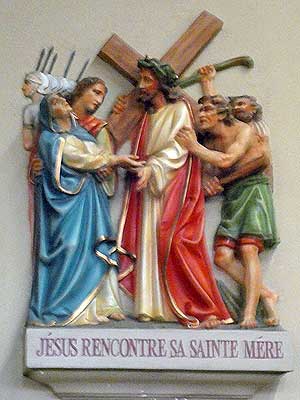
Stations of the Cross in French


The canopeum ... the cathedral's symbol
The canopeum (or umbrella) marks the church's rank as a a basilica. Originally these were functional pieces. When the Pope arrived, his carriage was met with the umbrella to protect him from the elements. Now they are more symbolic with elaborate deigns. All major basilicas are in Rome. All other "minor basilicas" (such as this one) are linked with one of the major ones, in this case with the Basilica of St. Mary Major in Rome.
The galero is a broad, flat-brimmed hat originally worn by members of the "lower clergy" (monks and priests who worked in parishes). In 1245, Pope Innocent IV made the red galero part of the uniform of cardinals. The usage of red with 30 tassels is for cardinals, green with 30 tassels for primates and patriarchs, green with 20 tassels for archbishops (above), and green with 12 tassels for bishops.
The windows were made at the Oidtmann studios in Linnich, Germany, and installed here in 1929. Each ones tells a story of the life of St. Louis IX. He was just 12 when his father died. He was actually the second son of Louis VIII, but after his older brother’s death, he became the next in line. His mother (Queen Blanche of Castile) ruled as regent until he turned 21 and assumed the throne.
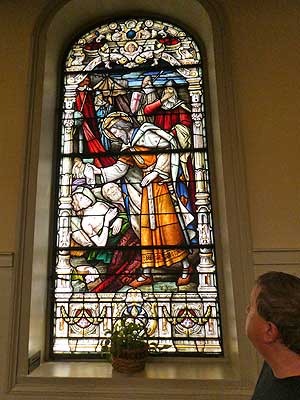

St. Louis Visiting the Lepers. Louis was renowned for his charity. Along with visiting and praying for the sick, he fed over 100 of the poor almost daily.
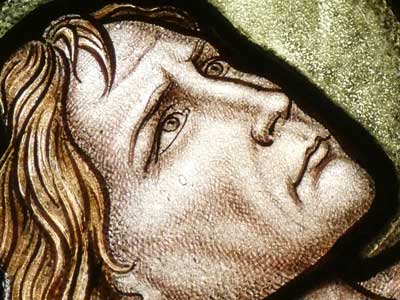
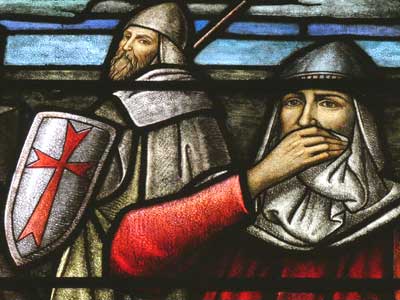
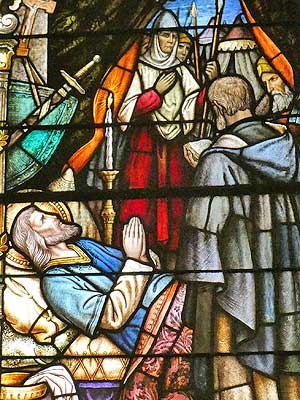

The Death of St. Louis IX (1270). He died of dysentery while on his second crusade in Tunisia.


Body of Louis IX is brought home to France (1271). Who are these mysterious onlookers? One is clearly scowling and the other is looking directly at the 'camera'.
The funeral of the king lasted 10 months. His casket was draped with a Christian flag and he was entombed at the Basilica of Saint Denis. His remains were subjected to a process known as Mos Teutonicus, a common custom used in Europe in the Middle Ages for nobles. Since their burial plots were often located far away from their place of death, the flesh was removed from the body by boiling so that the bones could be transported hygienically from distant lands back home.


The Canonization of St. Louis. Louis IX was proclaimed a saint of the Catholic church by Pope Boniface VIII in 1297.


A red galero hat ... A pair of monks
return • continue

